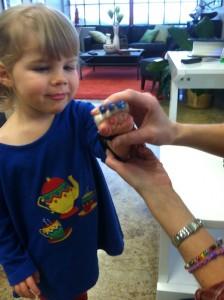Over the last 6-12 months we have seen countless stories about how 3D printing is helping to change the lives of those in need, with the use of customized, cheap prosthetic devices. This story is out of Huntsville Alabama,  and involves a two year old toddler named Kate Berkholtz, who was born without fingers on her left hand. Prosthetic devices for children are extra costly because they outgrow them so quickly, requiring expensive upgrades or even an entirely new device. For Kate’s family the costs of traditional prosthetics were out of their budget. Literally it could cost them tens of thousands of dollars a year.
and involves a two year old toddler named Kate Berkholtz, who was born without fingers on her left hand. Prosthetic devices for children are extra costly because they outgrow them so quickly, requiring expensive upgrades or even an entirely new device. For Kate’s family the costs of traditional prosthetics were out of their budget. Literally it could cost them tens of thousands of dollars a year.
Instead they turned to 3D printing for help. Jason Hundley’s firm, Zero Point Frontiers, with the help of intern Shawn Betts, was able to design, customize, print, and assemble the new finger device for Kate within a day. The materials for one device costs just around $5, which is a far cry from the thousands that doctors wanted for a similar product. With the new finger device, Kate is now able to use her hand in a much more efficient manner, allowing her to play just like the rest of the kids her age.
Hundley and his team have even greater plans for the future of these devices.
“We’ve talked about modularizing it. You know, for lack of better term, like a Swiss Army knife. We’re talking maybe just make a locked hand so she could ride a bike. And you could do that with the 3-D printing because my cost of printing those – the plastic on that is like sixty cents. Print it, see if it works. If it doesn’t work, interchange it,” said
Hundley.
Dan Carsen of WBHM, in Alabama, had an interesting commentary with Hundley in which the subject turned to the future of these prosthetic devices. Hundley stated that he could not wait for “fully automated, robotic, neuro-controlled prosthetic for $5,” to which Carson replied “How far away is that,”. Hundley’s response, “Probably about 10 years. Researchers have already connected sensors to nerves so people can feel through prosthetics. And some are gearing up to print organs. But right now, a simple plastic printed hand is making a little girl and her parents happy as she picks things up in ways she couldn’t before.”
Clearly the future is bright, and 3D printing is leading the way. This story about Kate is being repeated all over the world, at a pace which is exponentially progressing. Discuss Kate’s story at 3DPrintBoard. The full interview with Hundley can be listened to below, thanks to NPR.
Subscribe to Our Email Newsletter
Stay up-to-date on all the latest news from the 3D printing industry and receive information and offers from third party vendors.
You May Also Like
NSF Awards Kentucky $1M for Advanced Manufacturing
The National Science Foundation has awarded a $1 million grant to the University of Louisville for the Advancing Manufacturing and Building Construction Technologies (NSF AMT) project. This initiative is part...
3D Printing News Briefs, May 11, 2024: 3D Printed Stent, Tower, Sculptures, & More
We’re starting off with medical research in today’s 3D Printing News Briefs, as researchers in Korea used CT images and 3D printing to fabricate an educational simulator for a mastoidectomy....
3D Printing Unpeeled: Wind Turbines, Probiotics and Lenses
TPI Composites, ORNL and Ingersoll Rand are working to make wind turbine tooling segments that can be 18.3 meters long. These elements also include resistive wires that help keep the...
Tethon 3D Releases Cost-effective Bioprinter
Tethon 3D, known for its ceramic-loaded DLP materials, custom resins, and DLP 3D printers, has recently released a bioprinter. Vat polymerization printers like DLP systems have been widely used by...
































